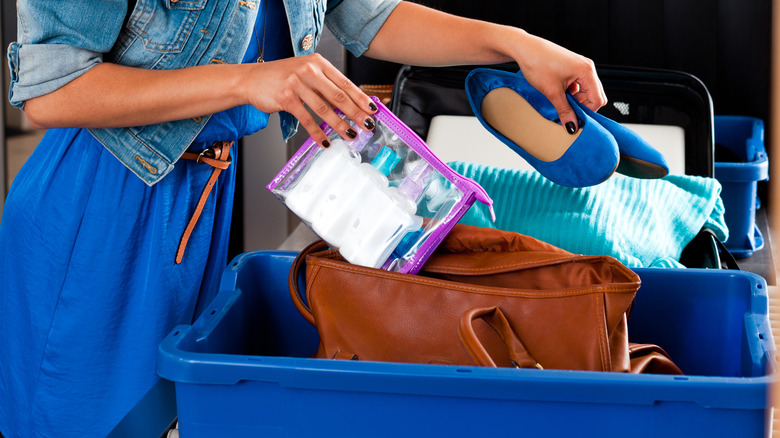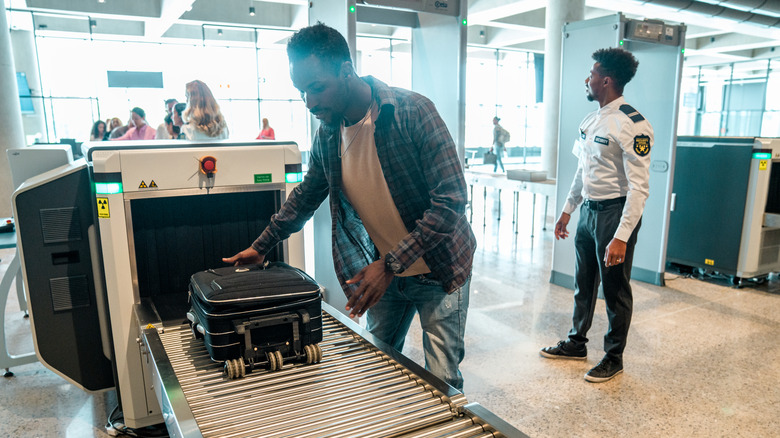What Really Is The Deal With TSA's Frustrating Inconsistencies? An Expert Weighs In
No one wants to be "that guy" (or gal) holding up the airport security line, confused about taking off their shoes and removing their bag of liquids. Unfortunately, even the most educated travelers can sometimes feel befuddled. For instance, some TSA checkpoints don't make you take your laptop out while others do, and some require fliers to remove their shoes and belts while others insist you keep them on.
So what's the deal with TSA's inconsistent rules and procedures? To find out, Explore exclusively reached out to Mr. Chris Fuglestad, assistant director for health and safety at a private university. As the expert tells us, there are several reasons why TSA might change its security practices, including the size and layout of the airport, the security equipment available, and the number of travelers passing through.
Another explanation for why TSA seems to be inconsistent is that, well, it's allowed to be. "Perhaps less common knowledge is that while the TSA sets baseline rules for screening passengers, each airport is able to adapt these processes to optimize efficiency and maintain their own safety standards," Mr. Fuglestad explains. You might find that larger airports are quicker to adopt new technologies that allow you to keep your items in your bags, for example, while smaller airports may enforce more thorough requirements. The health and safety expert adds that you'll also find different practices in place at airports with TSA PreCheck and Clear compared to those that don't offer expedited screening services.
How to find your airport's TSA rules before traveling
If airport security screenings trigger your airport anxiety — especially when they seem inconsistent and unpredictable — the good news is that you can often find out your hub's rules before you arrive. Mr. Chris Fuglestad shares that most airports list details about their TSA screening procedures on their official websites. Doing a quick search online can be an easy way to feel more relaxed and prepared when entering the security line.
Mr. Fuglestad notes that the general TSA website can also be useful, including its "What Can I Bring?" tool. Rules determining which items are safe to bring on board the plane, which need to be kept in your checked luggage, and which should be left at home are generally standardized across U.S. airports. The expert also suggests fliers enrolled in TSA PreCheck and other expedited screening programs confirm which airports offer special lanes to avoid disappointment on travel day.
"Finally, if they are unable to find information online, travelers can reach out directly to the airport's customer service line or social media accounts for real-time information on any unique procedures before their trip," Mr. Fuglestad says. This is the most direct way to get your questions answered and quash any doubts. "Pro Tip: I often find that social media accounts will get you quicker customer service!"
Be prepared for changes at the airport
Even if you're familiar with your airport's TSA practices and rules, things can — and do — change. "It's worth noting that the TSA constantly updates its procedures based on new security intelligence, technology, and current events. Because of this, even frequent travelers might encounter unexpected changes, such as modified screening for certain electronics or changes in prohibited items," Mr. Chris Fuglestad tells Explore. With this in mind, it's helpful to come prepared. If you're using the standard security line, be aware that you may need to take off your shoes, belt, and outerwear when going through the checkpoint. Mr. Fuglestad also suggests packing appropriately in case you're instructed to remove your electronics and liquids from your carry-on bag.
To streamline the process, the health and safety assistant director recommends applying for TSA PreCheck or Clear to eliminate some of the hassle associated with going through security. Keep in mind, however, that these options, along with any of TSA's procedures, may not apply when traveling outside the U.S. Mr. Fuglestad warns, "It is important to remember that international airports will have different standards, processes, and expectations — including during transit layovers — and it is important to research this ahead of time to avoid losing something valuable while going through security."


